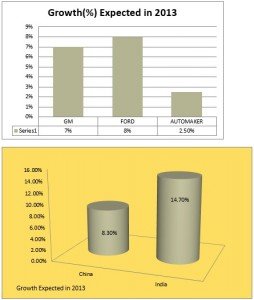Analysis of Automobile sector
The word automotive was created from the Greek word “autos” meaning self and Latin word “motivus” meaning motion to represent any form of self-driven vehicle. The term was proposed by Elmer Sperry. It is one of the world’s most important sectors by revenue.
Before we move on to analyzing the trends of the industry and gain insight into where it currently stands or where it is heading for, let us have a brief idea about how did it all start from i.e. let us look at a small picture of where it came down from?
When and where did it all start?
After the age when horse led carriages were used, the advent of the horseless carriage -the automobile industry started in the 1890’s. United States was the country which led the world in automobile production. In 1929 before the Great Depression, the United States used to produce around 32,028,500 automobiles which constituted 90% of the world production.
After World War II, the share of the U.S. reduced to 75%. In 1980 Japan overtook the U.S. and became the world leader in 1994.
What is the current position?
China presently holds the top spot with 13.8 million units. In 2012 China produced around 19.2 million units almost twice the production of automobiles in the U.S which produced around 10.3 million units whereas Japan produced 9.9 million units. In the year 2010, emerging markets accounted for 51% of the global light vehicle sales.
As it is evident that China today leads the world in terms of motor vehicle production, which when analyzed from the point of view of the Business Portfolio Matrix of the Boston Consultancy Group(BCG) can be classified into the category of Star. Business Portfolio Matrix of the BCG (Boston Consultancy Group) classifies SBU’s into four categories: Stars, Question Marks, Cash Cows and Dogs as per the business position respectively from good to bad.
The company wise production list worldwide in terms of production of automobiles is as follows:
|
1. General Motors
|
|
2. Volkswagen
|
|
3. Toyota
|
|
4. Hyundai
|
|
5. Motor Ford
|
|
6. Nissan
|
|
7. PSA
|
|
8. Honda
|
|
9. Renault
|
|
10. Suzuki
|
Where does it look to be moving?
As per the Detroit Branch of the Boston Consulting Group, if we are to believe them by 2014, 1/3 rd of the world’s demand will be in 4 BRIC markets (Brazil, Russia, India, China).
The Society of Indian Automobile Manufacturers (SIAM), apex body of the Indian automakers said that industry would miss all growth targets in the current fiscal year as they mentioned the following statistics:
-The industry is heading towards its worst performance of this decade as car sales have declined 12.5% to 173420 units in January, 2013 its third consecutive slide and the fifth in six months. The carmakers have now pinned all their hopes on fresh sops from the new budget.
But that’s the story in India. In U.S. the auto sales soared in 2012 to rise nearly 14% to a post-recession high of 14.5 million. The sales expectation for 2013 is 15 million. Sales here will also receive a boost from 5, 00,000 additional lease returners who will lease or buy a new vehicle when their current lease would end.
In the first five months of 2013 General Motors Company led with a market share of 18.0% in U.S. followed by Ford Motor Co. with a 16.4% market share. Toyota Motors Corp. has a market share of 14.2% and Chrysler-Fiat a 11.7% market share. Point to note is that Toyota recaptured its crown from General Motors by selling 9.75 million vehicles globally as compared to GM’s sales of 9.29 million vehicles. Germany’s Volkswagen AG came third with sales of 9.07 million vehicles.
The auto industry is not out of the woods yet. The U.S. economy slowed down due to the fiscal uncertainty and concerns about global economic weakness. Even in 2013, this uncertainty is likely to persist. The encouragement that the economy will receive from the current competitive strength of the automakers is that the consumers will continue to benefit from exciting new models and technologies and potentially lower prices- as automakers fight for market share, making 2013 interesting to watch.
Growth predictions by companies for 2013 are as follows:
What can we analyze and understand?
High Concentration leading to cut throat competition: The auto industry is highly concentrated. The top 10 global automakers account for roughly 80% of the worldwide production and nearly 90% of total vehicles sold in the U.S. This tells us that the market is currently very competitive.
Economic downturn resulting in slow momentum:The global economic slowdown will reduce the momentum but growth will continue. The competition amongst the companies would get fiercer by the day and amidst mergers, acquisitions and deals, the consumers would benefit with new models and better price options. The automotive industry continues to face challenges that coincide with the current economy and the price of oil.
Consumers getting back to Budget Car syndrome: Consumers have turned to purchasing affordable cars instead of spending money on the luxury items. In the US, the fastest selling car segment is currently priced between 10000$ to 15000$.
Small is standing tall in figures: There has been a growing demand of smaller cars which in turn means higher fuel economy for the consumers and with the large number of smart cars and Mini coopers, the trend has been positive.
Growing Economic Disparity: The rich continue to look for top brands and luxury brands while middle class are moving towards more affordable car segments. The luxury car companies are benefitting by catering to this market segment. The demand for luxury cars is higher in China than other countries. This means even with the growing interest in economy cars, there are expanding luxury markets.
Reinvention with mobility in mind: As shared car market grows, industry experts from the auto industry need to devise plans like shared cars, smart cars, car rentals and taxis etc. This would increase mobility and help people to move without necessarily owning a car. This can make a big difference in big cities.
The practice of leasing as prevalent in North America: The practice of leasing is increasing in China and North America wherein the company can lease a car and sell it off at the end of the lease period. It allows consumers to update their cars to a newer model every few years, which in turn helps the automobile industry to continue to grow and have a good rate of turnover on the models every year.
Government policies: In 2009 when China had overtaken U.S. Beijing government had introduced a stimulus package, including tax incentives for small cars. It was scrapped in 2011 and quotas of registrations were imposed in order to control the traffic congestions. With the China Association of Automobile Manufacture predicting 8% growth in 2012 it was actually confined to 4.3%. The government of China expects the automobile industry to rise 7.8% to 20.8 million vehicles in 2013 from 19.3 million last year.
Weaknesses: Although based on demand and supply factors, the automakers are shifting their production facilities to new regions, the suppliers to automakers lack the financial strength to expand capacity in new markets. On the other hand, auto parts suppliers are sensitive to technology being transferred to local third parties as that can give rise to low-cost competitors.
Green cars –a distant reality: Rising fuel prices and global warming have turned the attention of automakers towards use of traditional fossil fuels or renewable sources of energy. U.S. is the largest hybrid car market I the world with sales accounting for 60-70% of global hybrid crisis.
What is important to understand and realize is that this dynamic market sector can show drastic changes but as seen above, they are linked and connected to various controllable and uncontrollable parameters. The environment of the business, the economy and the policies made by the various governments shall play a vital role in shaping the direction of this industry.
[The article has been written by Priyo Ranjan. He is presently pursuing his MBA from XISS, Ranchi.]



































